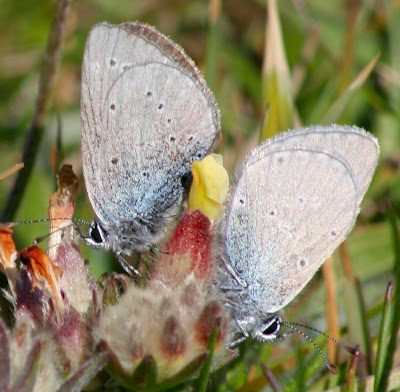6 keen volunteers made it on the day (plus Alfie the dog!).
After a quick saftey talk we split into pairs to get on with the tasks of the day.
The two main tasks were:
1/ raking the prepared soil in the 3mx35m scrapes, sowing the kidney vetch seed (10g/6m2) and then doing 'the stomp-shuffle' to make sure the seed had good contact with the soil.

 2/ Planting a wildlife hedge/ windbreak (198 hawthorns, 66 crab apples, 66 blackthorns) to protect the site from the wind.
2/ Planting a wildlife hedge/ windbreak (198 hawthorns, 66 crab apples, 66 blackthorns) to protect the site from the wind. 



Everyone had a go at each task. For the sowing task we initially planned to mix dried beach sand with the seed so that we could see where we had sown already, but this didn't work as well as expected. It was easier to mark out sections of 6m2 and sprinkle 10g of seed over this section.
Since it stayed warm and sunny we decided to have lunch on the reserve rather than heading off to the SWT office. Lots of wildlife was seen including skylarks, Stonechat, Coot, goldfinches but unfortunately no butterflies. We did find a Fox moth caterpillar and a rather funky ground beetle (Carabus nemoralis) which we think was a new find for the site.

I'd like to thank the 6 keen volunteers who did a fantastic job including Neil Gregory (SW Scotland BC branch chairman), Dr Jim Black (one of the founding members of the branch), Dr Andrew Masterman, Gill Smart (SWT reserves manager for SW Scotland), Chris Lamb and myself. Oh and not forgetting Alfie who kept us entertained!


I've since been sent a photo taken by Jim on the 27th of March showing a fantastic amouunt of germination getting underway. The success rate looks pretty high!

Other Small Blue Project news
At the weekend I spoke to Owen Figgis at the Branch 25th Anniversary celebrations and members gathering. He is growing kidney vetch seedlings for the project and says that they might be ready for planting on site within 2 months..ie end of May!
I also spoke to Dr Eric Watson, one of the founding members of the branch, who has also been growing kidney vetch seedlings. Unfortunately he reported that an overnight frost had killed most of his seedlings after he'd popped them outside. Another 4 people took packets of kidney vetch seeds to have a go. From the fantastic germination we've seen on the reserve, we may be able to move some plants from there to other parts of the reserve.











